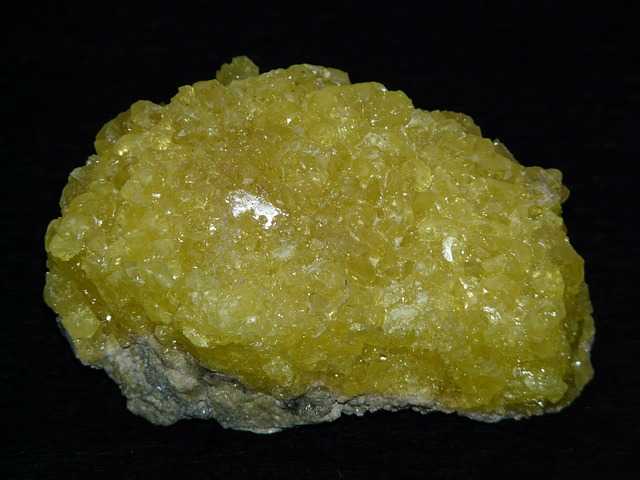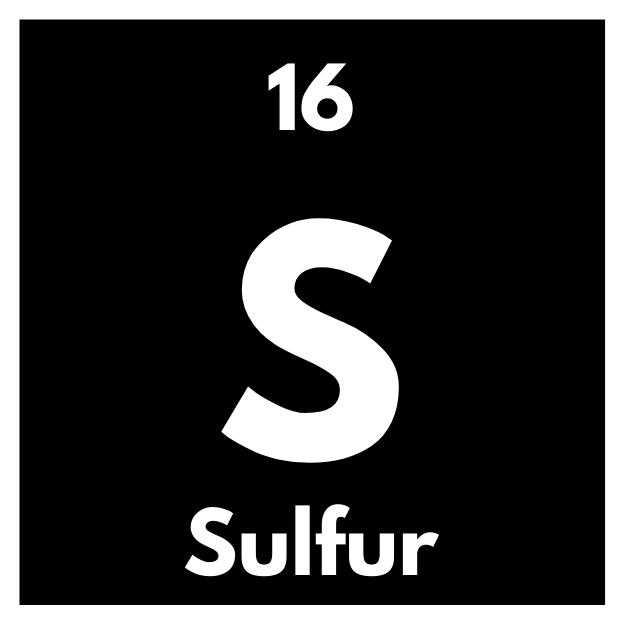Sulfur is a chemical element with the symbol S and atomic number 16. It is abundant, multivalent and nonmetallic. Under normal conditions, sulfur atoms form cyclic octatomic molecules with a chemical formula S₈. Elemental sulfur is a bright yellow, crystalline solid at room temperature.
Symbol: S
Atomic mass: 32.065 u
Atomic number: 16
Electron configuration: [Ne] 3s²3p⁴
Electrons per shell: 2,8,6
Melting point: 112.8 °C
Chemical series: Nonmetal, Chalcogen, Period 3 element
List of facts
Sulfur is a chemical element with the symbol S and
Sulfur has the atomic number 16
Sulfur is known as sulphur in British English
Elemental sulfur is a bright yellow, crystalline solid at room temperature.
Sulfur is the tenth most abundant element by mass in the universe and the fifth most on Earth
Historically and in literature sulfur is also called brimstone, which means “burning stone”
Sulfur is used in matches, insecticides, and fungicides
Hydrogen sulfide gives the characteristic odor to rotting eggs and other biological processes.
Sulfur forms over 30 solid allotropes, more than any other element

Sulfur has 23 known isotopes, four of which are stable
Antoine Lavoisier is the person who convinced the scientific community that sulfur was an element in 1777.
The most common isotope is 32S at 94.99%±0.26%
32S is created inside massive stars, at a depth where the temperature exceeds 2.5×109 K, by the fusion of one nucleus of silicon plus one nucleus of helium
Elemental sulfur can be found near hot springs and volcanic regions in many parts of the world
Historically, Sicily was a major source of sulfur in the Industrial Revolution
Today, it’s most common use is in the manufacture of sulfuric acid, which in turn goes into fertilizers, batteries and cleaners.
The main industrial source of sulfur is now petroleum and natural gas
Common naturally occurring sulfur compounds include the sulfide minerals, such as pyrite (iron sulfide), cinnabar (mercury sulfide), galena (lead sulfide) and sphalerite (zinc sulfide),
Its also found in stibnite (antimony sulfide); and the sulfate minerals, such as gypsum (calcium sulfate), alunite (potassium aluminium sulfate), and barite (barium sulfate)
Native sulfur is synthesised by anaerobic bacteria acting on sulfate minerals such as gypsum in salt domes
Fossil-based sulfur deposits from salt domes were once the basis for commercial production in the United States, Russia, Turkmenistan, and Ukraine
On Earth, elemental sulfur occurs naturally in volcanic emissions, including emissions from hydrothermal vents.
Most of the yellow and orange hues of Jupiters moon Io are due to elemental sulfur and sulfur compounds deposited by active volcanoes.
Sulfur, usually as sulfide, is present in many types of meteorites.
Sulfur forms stable compounds with all elements except the noble gases.
Treatment of sulfur with hydrogen gives hydrogen sulfide. When dissolved in water, hydrogen sulfide is mildly acidic
Hydrogen sulfide gas and the hydrosulfide anion are extremely toxic to mammals,
Copper, zinc, silver are attacked by sulfur – tarnishing
sulfur was known in ancient times and is referred to in the Torah
By the 3rd century, the Chinese had discovered that sulfur could be extracted from pyrite
Sulfur deposits in Sicily were the dominant source for more than a century.
The world production of sulfur in 2011 amounted to 69 million tonnes
Sulfur reacts directly with methane to give carbon disulfide, which is used to manufacture cellophane and rayon.
Calcium sulfate, gypsum, is mined on the scale of 100 million tonnes each year for use in Portland cement and fertilizers.
Sulfur is a component of gunpowder
Several vitamins contain sulfur, including biotin and thiamine.
Large quantities of sulfites are used to bleach paper and to preserve dried fruit.
elemental sulfur in a powdered form, is a common fungicide for grapes, strawberry, many vegetables and several other crops.
Elemental sulfur is one of the oldest fungicides and pesticides.
Most β-lactam antibiotics, including the penicillins, cephalosporins and monobactams contain sulfur
Sulfur is an essential component of all living cells.
A 70 kg human body contains about 140 grams of sulfur.
The main dietary source of sulfur for humans is sulfur-containing amino-acids, which can be found in plant and animal proteins
Elemental sulfur is non-toxic when one touches it
Sulfur properties
Physical properties |
|||||||||||||||
|---|---|---|---|---|---|---|---|---|---|---|---|---|---|---|---|
| Phase at STP | solid | ||||||||||||||
| Melting point | 388.36 K (115.21 °C, 239.38 °F) | ||||||||||||||
| Boiling point | 717.8 K (444.6 °C, 832.3 °F) | ||||||||||||||
| Density (near r.t.) | alpha: 2.07 g/cm3 beta: 1.96 g/cm3 gamma: 1.92 g/cm3 |
||||||||||||||
| when liquid (at m.p.) | 1.819 g/cm3 | ||||||||||||||
| Critical point | 1314 K, 20.7 MPa | ||||||||||||||
| Heat of fusion | mono: 1.727 kJ/mol | ||||||||||||||
| Heat of vaporization | mono: 45 kJ/mol | ||||||||||||||
| Molar heat capacity | 22.75 J/(mol·K) | ||||||||||||||
Vapor pressure
|
|||||||||||||||
Atomic properties |
|||||||||||||||
| Oxidation states | −2, −1, 0, +1, +2, +3, +4, +5, +6 (a strongly acidic oxide) | ||||||||||||||
| Electronegativity | Pauling scale: 2.58 | ||||||||||||||
| Ionization energies |
|
||||||||||||||
| Covalent radius | 105±3 pm | ||||||||||||||
| Van der Waals radius | 180 pm | ||||||||||||||
Other properties |
|||||||||||||||
| Natural occurrence | primordial | ||||||||||||||
| Crystal structure | orthorhombic | ||||||||||||||
| Thermal conductivity | 0.205 W/(m⋅K) (amorphous) | ||||||||||||||
| Electrical resistivity | 2×1015 Ω⋅m (at 20 °C) (amorphous) | ||||||||||||||
| Magnetic ordering | diamagnetic[2] | ||||||||||||||
| Molar magnetic susceptibility | (α) −15.5×10−6 cm3/mol (298 K)[3] | ||||||||||||||
| Bulk modulus | 7.7 GPa | ||||||||||||||
| Mohs hardness | 2.0 | ||||||||||||||
| CAS Number | 7704-34-9 | ||||||||||||||

